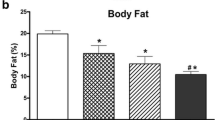Abstract
The effect of running activity on normal and inflamed knees was determined by light microscopic (LM) and scanning electron microscopic (SEM) observations on hamster articular cartilage. Animals were split into two groups; one housed in standard cages and one given free access to running wheels. Twenty-one days prior to analysis, half of each group was given an intraarticular injection of lipopolysaccharide (LPS) to cause an inflammation, the other half were uninjected. No remarkable changes were observed by LM in either the control running or nonrunning groups. In contrast, cartilage proteoglycan depletion, and pannus and synovial hyperplasia were equally observed in both groups of LPS-injected animals. SEM observations on the patellae from control animals found them to be free from damage to the articular cartilage. The joints of both the LPS nonrunning and running animals contained synovial hypertrophy with villus projection from the synovial lining. However, only the LPS-injected running hamsters had cartilage fraying over large areas of the articular surface, as well as areas in which the villus projections had been flattened. These results demonstrated that mechanical stress applied to a proteoglycan-depleted cartilage enhances the breakdown of the collagen matrix as judged by fibrillation, and may aggravate the inflammation by crushing the swollen synovial lining where it encroaches on the joint space.
Similar content being viewed by others
References
Bentley G (1971) Papain-induced degenerative arthritis of the hip in rabbits. J Bone Joint Surg 53B:324–337
Williams JM, Uebelhart D, Ongchi DR, Kuettner KE, Thonar EJ-MA (1992) Animal models of articular cartilage repair. In: Kuettner KE, Schleyerbach R, Peyron JG, Hascall VC (eds) Articular cartilage and osteoarthritis. Raven Press, New York, pp 511–526
Kalbhen DA (1983) Biochemically induced osteoarthrosis in the chicken and rat. In: Munthe E, Bjelle A (eds) Effects of drugs on osteoarthrosis. Huber, Stuttgart, pp 1763–1765
Lenzi L, Berlanda P, Flora A (1974) Vitamin A induced osteoarthritis in rabbits: An experimental model for the study of human disease. In: Articular cartilage. Proceeding of the symposium held at the Institute of Orthopaedics, Institute of Orthopaedics, London, pp 243–257
Pettipher ER, Higgs GA, Henderson B (1986) Interleukin 1 induces leukocyte infiltration and cartilage proteoglycan degradation in the synovial joint. Proc Natl Acad Sci USA 83:8749–8753
Matsukawa A, Ohkawara S, Maeda T, Takagi K, Yoshinaga M (1993) Production of IL-1 and IL-1 receptor antagonist and the pathological significance in lipopolysaccharide-induced arthritis in rabbits. Clin Exp Immunol 93:206–211
Otterness IG, Bliven ML, Milici AJ, Poole AR (1994) LPS-arthritis in the hamster: comparison of mobility changes with cartilage proteoglycan changes. Am J Pathol 144:1098–1108
Palmoski M, Colyer RA, Brandt KD (1980) Joint motion in the absence of normal loading does not maintain normal articular cartilage. Arthritis Rheum 23:325–334
Palmoski MJ, Perricone E, Brandt KD (1979) Development and reversal of a proteoglycan aggregation defect in normal canine articular cartilage after immobilization. Arthritis Rheum 22:508–517
Palmoski MJ, Brandt KD (1981) Running inhibits the reversal of atrophic changes in canine knee cartilage after removal of a leg cast. Arthritis Rheum 24:1329–1337
Borer KT (1980) Characteristics of growth-inducing exercise. Physiol Behav 24:713–720
Otterness I, Milici AJ, Bliven ML (1994) Some factors affecting inhibition and restoration of mobility after induction of an acute arthritis in the hamster. Agents Actions 40:224–227
Lammi M, Häkkinen T, Parkkinen J, Hyttinen M, Jortikka M, Helminen H, Tammi M (1993) Effects of long-term running on canine femoral head articular cartilage. Agents Action [Suppl] 39:95–99
Kiviranta I, Tammi M, Jurvelin J, Arokoski J, Säämänen A, Helminen H (1992) Articular cartilage thickness and glycosaminoglycan distribution in the canine knee joint after strenuous running exercise. Clin Orthop 283:302–308
Jurvelin J, Kivirana I, Säämänen A, Tammi M, Helminen H (1990) Indentation stiffness of young canine knee articular cartilage-influence of strenous joint loading. J Biomech 23:1239–1246
Arokoski J, Kiviranta I, Jurvelin M, Tammi M, Helminen H (1993) Long-distance running causes site-dependent decrease of cartilage glycosaminoglycan content in the knee joints of beagle dogs. Arthritis Rheum 36:1451–1459
Salter RB, Simmonds DF, Malcolm BW, Rumble EJ, MacMichael D, Clements ND (1980) The biological effect of continuous passive motion on the healing of full thickness defects in articular cartilage. J Bone Joint Surg 62A:1232–1251
Salter RB, Hamilton HW, Wedge JH, Tile M, Torode IP, O'Driscoll SW, Murnaghan JJ, Saringer JH (1984) The clinical application of basic research on continuous passive motion (CPM) for disorders and injuries of synovial joints. A preliminary report. J Orthop Res 1:325–342
Williams JM, Moran M, Thonar EJ-MA, Salter RB (1994) Continuous passive motion stimulates repair of rabbit knee articular cartilage after matrix proteoglycan loss. Clin Orthop 304:252–262
Williams JM, Brandt KD (1984) Exercise increases osteophyte formation and diminishes fibrillation following chemically induced articular cartilage injury. J Anat 139:599–611
Jasin HE, Noyori K, Takagi T, Taurog JD (1993) Characteristics of anti-type II collagen antibody binding to articular cartilage. Arthritis Rheum 36:651–659
Swann DA, Hendren RB, Radin EL, Sotman SL, Duda EA (1981) The lubricating activity of synovial fluid glycoproteins. Arthritis Rheum 24:22–30
McNeil PL (1993) Cellular and molecular adaptations to injurious mechanical stress. Trends Cell Biol 3:302–307
Author information
Authors and Affiliations
Rights and permissions
About this article
Cite this article
Shay, A.K., Bliven, M.L., Scampoli, D.N. et al. Effects of exercise on synovium and cartilage from normal and inflamed knees. Rheumatol Int 14, 183–189 (1995). https://doi.org/10.1007/BF00262296
Received:
Accepted:
Issue Date:
DOI: https://doi.org/10.1007/BF00262296




